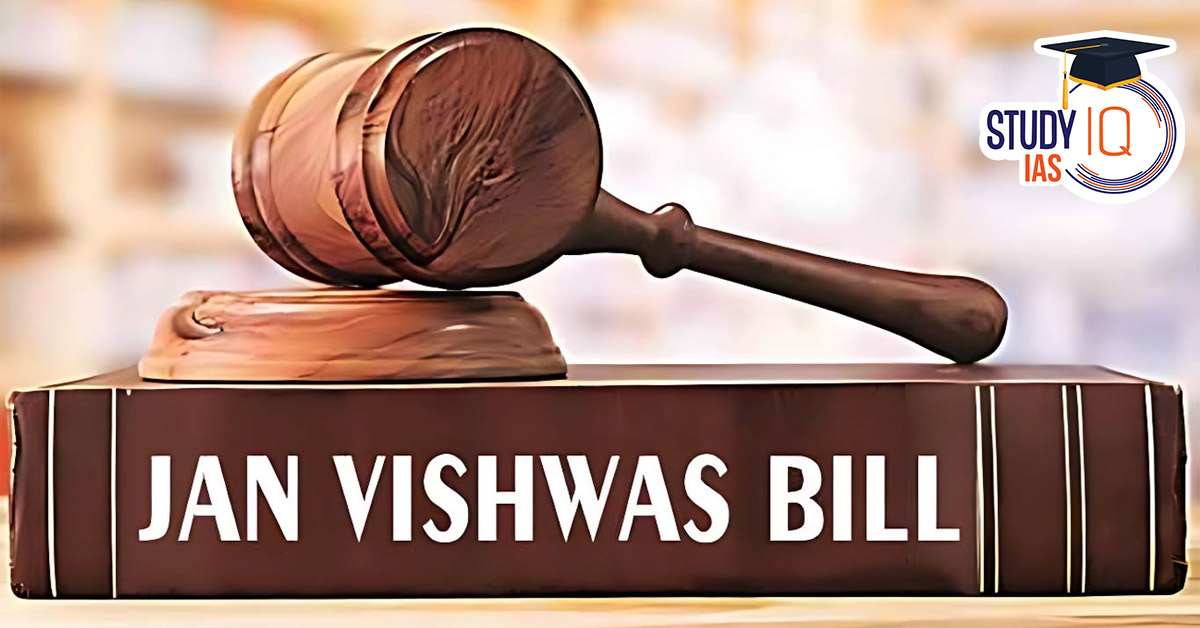Table of Contents
Context: The recently announced Jan Vishwas Bill 2.0 at the Union government level aims to simplify and humanize India’s legal framework.
Jan Vishwas Bill: State of India’s Legislative Framework
Legislative Data (Vidhi Centre for Legal Policy Report)
- The Vidhi Centre for Legal Policy compiled data on 174 years of legislative activity, covering 882 central laws.
- Key findings:
- 370 laws contain criminal provisions covering 7,305 crimes.
- Out of these:
- 5,333 crimes attract jail terms.
- 982 crimes attract mandatory minimum jail terms.
- 433 crimes attract life imprisonment.
- 301 crimes attract the death penalty.
- Criminal justice laws like the Bharatiya Nyaya Sanhita and the National Security Act account for only 25% of these crimes.
- The remaining 75% cover aspects of everyday life such as:
- Parent and childcare
- Gathering in assembly
- Mobility
Challenges with Existing Criminal Laws
Excessive Criminal Provisions for Minor Infractions
Some laws are rarely enforced but provide scope for the arbitrary exercise of power by officials.
- Examples of minor offences attracting harsh punishments:
- Milking a cow or buffalo on the street
- Failing to report the death of an animal within three hours
- Removing corpses by unprescribed routes
- Neglecting to provide proper exercise to a pet dog
- Distributing feeding bottles to a mother who cannot breastfeed
- Storing e-cigarettes
Disproportionate Punishments
The current system imposes lesser punishment for serious offences and severe punishment for minor offences:
- Mental Healthcare Act, 2017: Six months’ jail for:
- Failing to maintain records and fulfil reporting obligations.
- Performing brain surgery for mental illness without the patient’s consent and Board approval.
- Running a red light while driving can result in jail time comparable to forcing someone into labour.
- Impact: Distorts incentives and undermines public trust in the justice system.
Lack of Awareness and Misuse by Officials
Many citizens are unaware of these criminal provisions, making them vulnerable to exploitation.
- Corrupt officials may use obscure provisions to demand bribes or threaten action.
- Example: Recent digital arrest scams involved citizens paying bribes to avoid arrest for crimes they had not committed.
Overreliance on Criminalisation
- India’s legal framework reflects the frustration of trying to impose a modern state on an ancient civilisation.
- Over-criminalisation is a state-sanctioned system rather than a society-sanctioned process, making it unsustainable in the long run.
Criminal Justice System Challenges
- Overburdened Courts and Prisons: 75% of prison inmates in India are undertrials – they have not been convicted.
- There are 5 crore pending criminal cases arising from the 5,333 criminal provisions.
- Conviction Rates and Legal Process Issues: Conviction rates remain low.
- Courts are hesitant to pass sentences that do not meet a common sense test.
- Harsh penalties impact the poor and marginalized communities the most.
Structural and Institutional Barriers
Resistance from Bureaucracy: Under Jan Vishwas Bill 1.0 (enacted in 2023), several minor offences were proposed to be decriminalized across 42 laws.
- However, the actual reduction in criminal provisions was limited because civil servants resisted giving up penal powers.
Proposed Reforms Under Jan Vishwas Bill 2.0
- Principles for Criminalisation (Vidhi Report): The Vidhi Centre for Legal Policy recommends four guiding principles to justify criminal provisions:
- Protection of Value: Criminalisation must protect a value vital for society’s existence and public interest.
- Protection Against Clear Harm: Criminalisation must be justified by a direct and reasonable apprehension of harm.
- Effective and Efficient Solution: Criminalisation must be the only reasonable means to achieve the law’s objective.
- Proportionate Response: Punishment must be proportionate to the gravity of the harm caused.
- Removal of Arbitrary and Excessive Punishments: Jan Vishwas 2.0 aims to eliminate excessive criminal penalties for minor infractions.
- The Bill proposes to make laws more consistent and predictable.
- Public Consensus and Updated Legal Framework: A public consensus is needed to revise the legal framework based on the four principles.
- Legal reforms must be clear, concise, consistent, comprehensible, and implementable.
- Example: The Mental Healthcare Act’s penalties for administrative lapses vs. medical malpractice reflect the need for consistency.
- Focus on Restorative Justice: Shift from a punitive to a rehabilitative and restorative justice model.
- The goal is to ensure that the justice system works towards correction rather than mere punishment.
- Legal reforms must be clear, concise, consistent, comprehensible, and implementable.
Conclusion
The reforms should
- Align criminal laws with public interest.
- Make criminal laws enforceable and predictable.
- Strengthen citizens’ trust in the legal system.
Accountability
Criminal provisions must be assessed for their impact on:
- Human rights
- Society
- Fiscal resources
- Justice system capacity.


 SLAPP Suits: Meaning, Examples, Impact o...
SLAPP Suits: Meaning, Examples, Impact o...
 Finance Commission of India, Articles an...
Finance Commission of India, Articles an...
 High Number of Pending Cases in Supreme ...
High Number of Pending Cases in Supreme ...

























